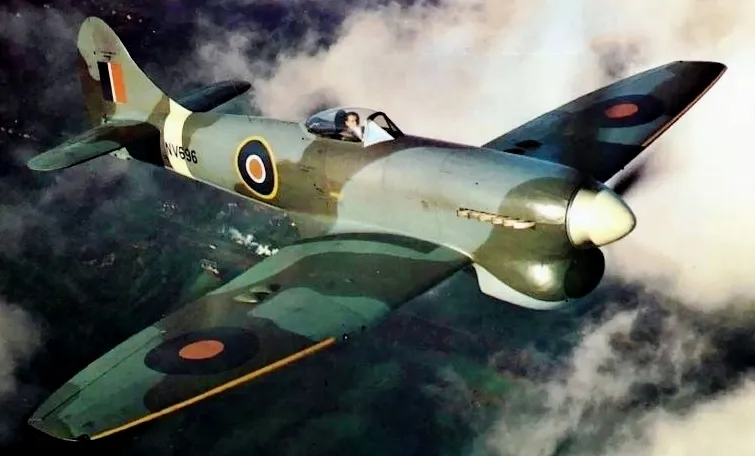Tempest (Total: 8, Canadian: 8, Group 0)
Hawker Tempest

Hawker Tempest Mk. V, RAF (Serial No. NV596)
The Hawker Tempest was a British fighter aircraft primarily used by the Royal Air Force (RAF) in the Second World War. The Tempest, originally known as the Typhoon II, was an improved derivative of the Hawker Typhoon, intended to address the Typhoon's unexpected deterioration in performance at high altitude by replacing its wing with a thinner laminar flow design. Since it had diverged considerably from the Typhoon, it was renamed Tempest. The Tempest emerged as one of the most powerful fighters of World War II and was the fastest single-engine propeller-driven aircraft of the war at low altitude.
Upon entering service in 1944, the Tempest was used as a low-level interceptor, particularly against the V-1 flying bomb threat, and as a ground attack platform, in which it supported major events such as Operation Market Garden. Later, it successfully targeted the rail infrastructure in Germany and Luftwaffe aircraft on the ground, as well as countering such attacks by German fighters. The Tempest was effective in the low-level interception role, including against newly developed jet-propelled aircraft such as the Messerschmitt Me 262.
The further-developed Tempest II did not enter service until after the end of hostilities. It had several improvements, including being tropicalised for combat against Japan in South-East Asia as part of the Commonwealth Tiger Force.
The Tempest was a single engine fighter aircraft that excelled at low-level flight. In service, its primary role soon developed into performing "armed reconnaissance" operations, often deep behind enemy lines. The Tempest was particularly well suited to the role because of its high speed at low to medium altitudes, its long range when equipped with two 45-gallon drop tanks, the good firepower of the four 20mm cannon and the good pilot visibility. The three-piece windscreen and side windows of the Tempest had directly benefited from examination of captured Focke-Wulf Fw 190s, improvements included the careful design and positioning of the frame structure, blind spots being reduced to an absolute minimum. It had a bullet-resistant centre panel made up of two layers, the outer 1.5 in (38Â mm) thick and the inner 0.25 in (6.5Â mm). Wikipedia
Tempest Mk. V serial EJ588
s/n EJ588
Hawker
EJ 588
Known Units: 3
last update: 2025-September-15
Tempest Mk. V serial EJ639
s/n EJ639
Hawker
EJ 639
Known Units: 274
last update: 2025-September-15
Tempest Mk. V serial EJ685
s/n EJ685
Hawker
EJ 685
Known Units: 56
last update: 2025-September-15
Tempest Mk. V serial EJ788
s/n EJ788
Hawker
EJ 788
Known Units: 80
last update: 2025-September-15
Tempest Mk. V serial EJ845
s/n EJ845
Hawker
EJ 845
Known Units: 56
last update: 2025-September-15
Tempest Mk.V serial EJ867
s/n EJ867
Hawker
EJ 867
Known Units: 56
last update: 2025-September-15
Tempest Mk. V serial NV943
s/n NV943
Hawker
NV 943
Known Units: 274
last update: 2025-September-15
Tempest Mk. VI serial NV999
s/n NV999
Hawker
NV 999
Known Units:
Crashed on delivery flight.last update: 2025-February-05
1946-February-11 Taken on Strength 2022-02-07
1947-February-18 Struck off Strength 2019-08-20
